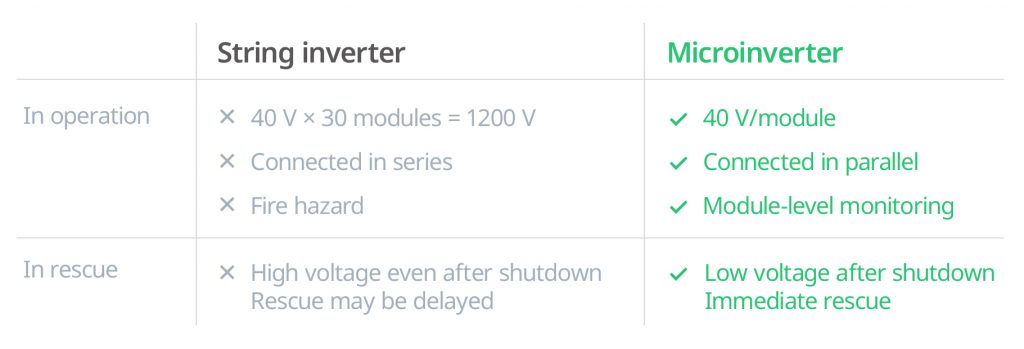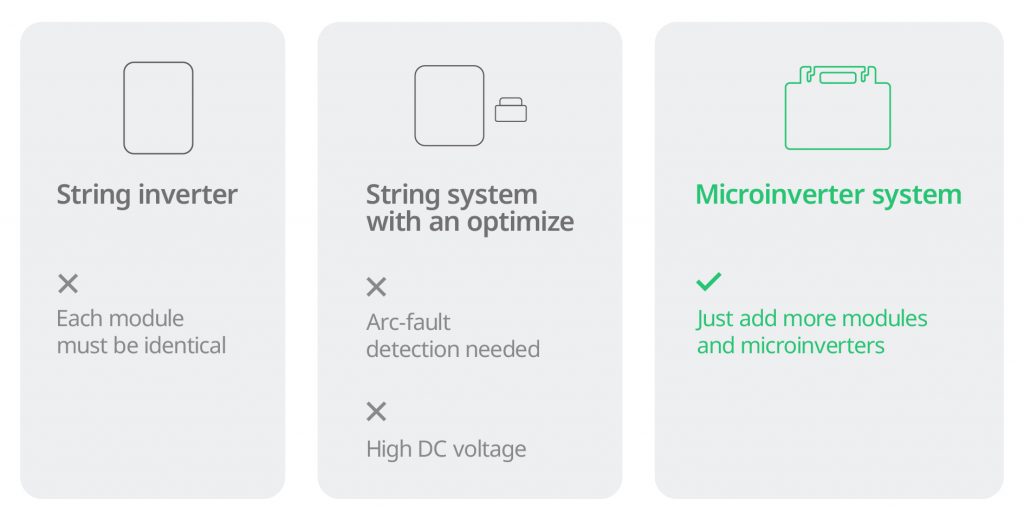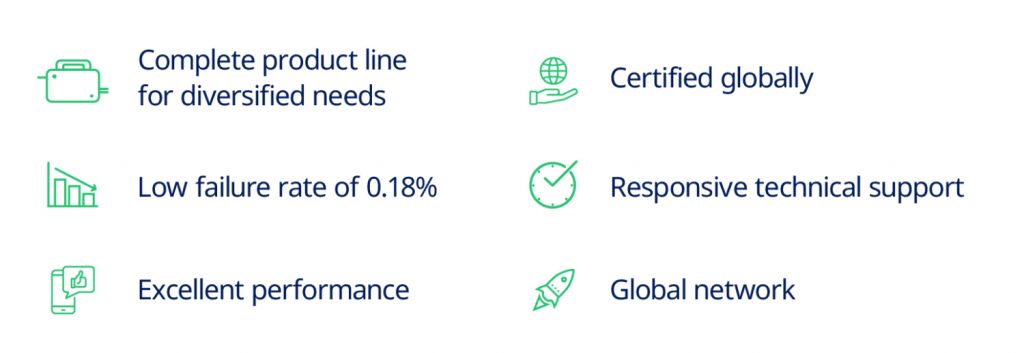How to Gain Maximum Solar Power: Microinverters or String?
GETTING THE MOST OUT OF A SOLAR POWER SYSTEM
How do you get the most out of your solar power system? The key lies in which type of inverters you have: microinverters or string inverters.
Because while solar panels (modules) play an important role, it’s the inverters that hold the key to how efficient a solar power system is.
But how do you decide which inverter is right for you? Whether you’re a homeowner or an installer, there are several factors to consider.
Read on to find out more.
1. SAFETY
Let’s start with safety – arguably, the most important consideration.
Safety during operation
What risk do string systems or microinverter systems pose to homeowners?
String systems run on high voltage
At about 40–50 V, the voltage carried by a single module in a string system is low. But string inverters are connected in series. And when you connect 20–30 modules in a series, the DC voltage of the entire system can rise to as much as 1,000–1,500 V.
That poses a significant danger to people’s safety. It’s also risky for your building. With a disconnected wire, the system can initiate a high-voltage arc, making it a fire hazard.
Microinverters isolate modules
By contrast, microinverters are connected in parallel and each only carries a voltage of 40 V, significantly downgrading the safety risk in the first place.
What’s more, module-level monitoring makes it easy for you to keep on top of things and detect potential problems.
Safety during rescue
If a fire were to break out, are there any differences between the two types of systems in the risk posed to firefighters during a rescue operation?
String systems – high voltage after shutdown
A string inverter-equipped system will carry a high voltage even after it has been shut down. So, it still poses a great danger for users and firefighters. All firefighters can do is wait until all the panels have burned out.
Microinverter systems – low voltage after shutdown
But a microinverter-equipped system carries a low voltage after shutdown, so it poses no danger to rescue staff.

2. RETURN ON INVESTMENT/PROFIT
When considering the return on your investment, what you should ask is: How long is the payback period?
This depends on several different factors.
Cost
First, consider the total costs. Not just the upfront costs but also:
- Equipment replacement costs during the service life of the whole system; and
- Maintenance costs during the service life.
Microinverter system costs
With warranties extending to 25 years, there will be no need for you to incur equipment replacement costs during the operational life of your microinverter system. And minimal labor effort is needed for maintenance. A simple replacement of a module is enough.
String system costs
By contrast, problems with modules in a string system result in much higher time and labor costs. What’s more, problems with the string inverter itself mean the whole system must be powered off.
The amount of electricity generated by the system
A microinverter system has a similar payback period to a string system. That’s because a microinverter system produces 5–30% more power than a string system.
There are three reasons why:
a) The effect of shading
First, one of the main advantages of microinverters is they slash the impact of shading.
Photovoltaic (PV) cell electrical output is sensitive to shading. If even a tiny part of a module becomes shaded – from trees, dense building spacing, bird droppings, snow, dust or other debris – that module’s output will plummet.
How does shading affect a string system? Here’s a useful analogy.
Picture a broken wooden barrel with unequal staves (the strips of wood that make up the barrel). How much water can the barrel hold? Only up to the height of the shortest stave.
Scientists call this the ‘law of the minimum’. And the principle applies equally to a string system.
The string of panels effectively acts as a single larger panel. Where shading causes the output of one or more modules to drop, the whole system’s output falls to the level of the lowest-producing module.
But a microinverter system is far more robust. It gets around the problem with its module-level Maximum Power Point Tracking (MPPT) technology. This electrically isolates solar panels from each other.
One underperforming module will not affect the operation and performance of the other modules or the system as a whole.

b) Microinverters have greater installation capacity
The space restrictions on your roof might not allow all modules to be placed in the same direction. For example, you might only have space to place three modules facing north and two modules facing west. With string inverters, this mismatch in orientation leads to a loss of power.
Thanks to MPPT, however, you don’t get mismatch losses with microinverters. That means microinverters enable greater installation capacity.
c) Starting power
The starting power of a microinverter system is lower. Microinverters start working earlier in the morning and carry on working later in the evening than a string system.
This makes a microinverter system about 1–1.5% more cost-effective.
Power consumption and the local electricity price
Power consumption will largely depend on your family’s energy-using habits. Factors like how many appliances you have; whether you take care not to waste energy, etc.
The price of electricity will depend on your local grid operations. Factors affecting the local electricity price include population density, fuel prices (coal, natural gas, oil), energy structure and whether there’s any government subsidy.
Power consumption and the local electricity price are generally fixed factors for families. So, when you’re comparing and contrasting return on investment, you should mostly focus on the first two factors – system costs and the amount of electricity generated.
3. SERVICE LIFE
You can generally expect the power output of modules to be stable for 25 years. What about inverters?
Service life of string inverters
The service life of string inverters doesn’t cover that of modules. So, there’s a good chance a string inverter might break down when your modules are still working. And string inverters tend to come with a warranty period of only 5–10 years.
Service life of microinverters
By contrast, the warranty period of microinverters often extends to 25 years, which means you won’t need to worry about replacement during the operating life of your PV system.
4. MAINTENANCE FOR THE WHOLE SYSTEM
When it comes to maintenance for the whole system, there are two questions you should ask:
- Is it time and labor-consuming?
- Does it have high technical requirements? If so, you’ll have to reach out to technicians every time a problem occurs.
Here, there are sizable differences between string systems and microinverter systems.
String system maintenance
First, the modules.
If you experience a problem with the modules in a string system, you’ll need professional operational and maintenance personnel, using professional tools, to check each module. One by one. This will take far longer and will result in higher labor costs than checking issues with modules in a microinverter system. What’s more, the technical requirement is rigorous.
Second, the string inverter itself.
A string inverter contains high voltage DC, which is very dangerous. So, if you experience a problem with the string inverter, you will need to power off the whole system during maintenance.
Microinverter system maintenance
By contrast, if a problem occurs with a microinverter, only the corresponding modules will be affected.
Whereas a problem with a string inverter means you must shut down the whole system, with a microinverter fault the rest of the system can remain operational. And a straightforward replacement of that microinverter will solve the problem, saving you time, effort and money.
What’s more, with a microinverter system you can monitor the power production of each module remotely. That means you can accurately spot and identify any modular failures in real-time – wherever you are in the world.
In summary, a fault in a string system is far more costly than a fault in a microinverter system. You will also need to arrange for someone to repair a fault in a string system much sooner than you would for a fault in a microinverter system.
For example, if a module breaks down in a microinverter system, only that module will be affected. But when a module breaks down in a string system, the whole string of modules will be affected.
5. FLEXIBLE CAPACITY EXPANSION
If you want to expand a system’s capacity in the future, how easy will that be?

String system expansion
With a string system, capacity is determined by the poorest-performing module. Once again, that’s down to the law of the minimum.
What this means is that each module must be identical. The same brand, the same height, the same direction, etc. So, if you want to expand capacity, you will have to consider various factors, such as direction and height.
Microinverter system expansion
By contrast, boosting the capacity of a microinverter system is straightforward. You simply add more modules and microinverters.
String systems with an optimizer
Optimizers can make up for some of the downsides of string inverters by providing benefits such as module-level MPPT, module-level monitoring, and rapid shutdown.
However, string systems with an optimizer still have problems.
- Expanding power station capacity is not easy.
- You need arc-fault detection to mitigate the fire hazard. That means higher costs.
- And there is a high DC voltage when the string system is being operated. That makes it unsafe for personnel.
WHY HOYMILES?
Once you’ve decided whether to go for a microinverter or a string system, you still need to choose a brand. One that scores highly for the features listed above.
With high reliability, a low failure rate, and excellent performance levels, Hoymiles’ microinverters do just that.

Product quality
Our microinverters are certified globally and guaranteed by both environmental and electrical tests. They are subjected to more rigorous reliability testing than normal certification standards. That’s why Hoymiles’ microinverters have a low failure rate of less than 0.18%.
Our product lines vary from 1-in-1 to 6-in-1 and can satisfy different power station customers.
What’s more, our products have a high-power output, they can be adapted to most mainstream components, and they are constantly updated – reflecting Hoymiles’ leading position in research and development.
Service
With a warranty that’s extendable to 25 years, Hoymiles is known for its responsive pre-sales service and after-sales technical support.
Our marketing network covers over 30 territories, and we have installers available in more than 70 countries and regions.
If you have a problem, we’ll provide you with feedback within 2–24 hours and a solution within just 3 working days.
Performance
Our microinverters have:
- High CEC weighted efficiency (96.5%);
- Excellent MPPT efficiency (99.8%); and
- An impressive power density of 920 W/L (1500 model).
So, if you’re a homeowner, you can rest assured of the quality and efficiency of our products and service.
And if you’re an installer, you can rely on our products to boost your profits and drive business expansion.
